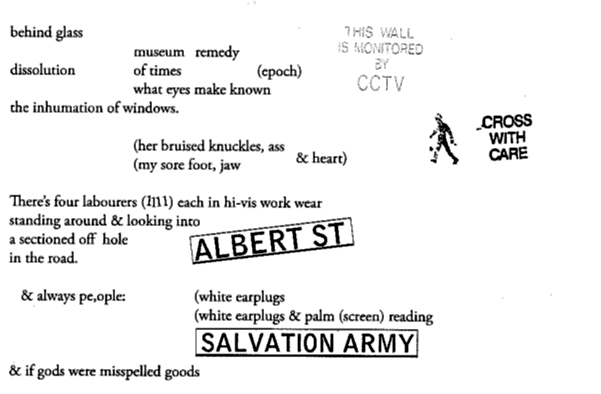But what does Frascarelli’s use of the dérive and playful studying of the terrain achieve? From a psychogeographic standpoint it leads me to view the poem as an attempt to de-spectacularise Sydney Road by deconstructing and recomposing ‘the rigidly historic narrative’ embedded within it (Soja 1). Social theorist, Edward W Soja, suggests that one way we can achieve such a deconstruction is by re-collecting and creatively juxtaposing material: ‘experimenting with assertions and insertions of the spatial against the prevailing grain of time’ (2). This spatial experimentation correlates to both Frascarelli’s approach to poetry, and the SI’s aims of creating events or situations which are ‘not random acts’, but ‘constructed interventions with organized aesthetic aims and political rationale’ (Elias 823). Such a political and spatial consideration of place allows Frascarelli to interrogate the spectacle in Australia and its representations of history and culture – allowing alternative ideas surrounding these concepts to surface. This is further evident in section ‘#4’, where Frascarelli elucidates not just what occupies the road in its people and shops, but what lies beneath it, in both a symbolic and literal sense:
it’s a complex of surfaces; spat gum spots on the footpath cigarette butts wrappers receipts et alia : gilt route 55 detritus & coiled postures, but where there was blood washes away soonest & only few (would you remember) are haunted by the reminders of transient stains
He also goes on to acknowledge:
The Wheel compressing the frailer song unheard in the road of stone, steel & bitch-uh-men
This compressing of ‘the frailer song’ unable to be elucidated, is then juxtaposed to the next section, ‘1850’, where he details the men and process involved in the literal and physical laying of the road. This juxtaposition further reiterates Frascarelli’s interest in the history of our spectacular society here in Australia. For the birth of Australia was one grounded in the propagation of capitalism, of spectacular society, through the process of colonisation. The fact that non-indigenous, or rather, Australian’s with a past of migration, have no foundation beyond capitalist / consumerist society, and that we are firmly grounded in ‘things’, Frascarelli ironically points out in section ‘#18’:
each gaping mouth of the old shopfronts & prevailing What’s life without ?
In search of something more enduring than these ‘things’ Frascarelli’s poem elucidates what he believes are the more localised and significant aspects of Australian culture and history, such as our multicultural society (see excerpt of section ‘#33’ for an example) and our Indigenous heritage as in the following section, ‘#2’:
(bunjil) (waa) IRAMOO, what the deathless birds dreamed between the two creeks a man & a woman were created from bark & clay relative to sky, sun, water, trees, air etc. hand stitched water & air bags, broken open & blown into night sky. & into the same dust … so much is wonderful but never enough the way it is
Frascarelli’s approach to rendering the contradictions inherent in such diverse places as an Australian inner-city road de-emphasises the mainstream, and often romanticised, colonial narrative of white settlement: re-iterating the dérive’s ability to challenge ‘dominant formations of culture and history’ (Downing 262). A similar effect is also achieved in the poem through the collaging of found images / texts of Sydney Road. Collage is a key aspect of detournement, a ‘method for integrating pre-existing cultural productions into a superior constructed situation’ (Waxman 130). This is most evident in the following excerpt, ‘#47’, where the poet collages the ‘cultural productions’ that occupy the space within Sydney Road alongside his own writing. The following are two excerpts of such an approach in this section:
what draws me back here? A reprise? Obligations? Errands? Boredom? Poetry? so much stuff ? “I” , no context of “I” , in uncollective. (the girl with half her hair green coeval pediment, the days

This ironic re-arranging of pre-existing material makes ‘the possibilities for rejuvenation and reinvention appear endless …’ because it allows for a transforming ‘through action and perception from a functionalist, workaday place to one of games and encounters’ (Waxman 130). Again, like the use of dérive, detournement emphasises the idea of ‘play’ in the S.I.’s model of psychogeography and heightens the readers awareness of the tangibility of ideas integral to the propogation of spectacular society: such as time, money and ownership (Waxman 130).









